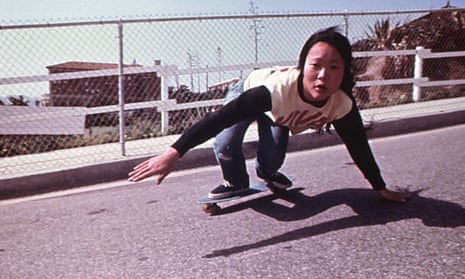My first and last experience of skateboarding was not quite as, ahem, rad as those detailed in this film. It was 1977, and I was a teenager staying with my cousin in Boston, Massachusetts; one summer evening I was watching him and his lank, floppy-haired friends skateboarding and shyly, I asked if I might “have a go” – an unhappy Home Counties phrase which somehow signalled the disaster that was then only minutes away.
Looking sharp in my midnight blue flared jeans and casually unbuttoned denim waistcoat, I climbed wobblingly on his board and, standing stock, still began to trundle downhill, quite without the sexily rhythmic swoops and curves and swerves they’d all been demonstrating. All I did was cause an accelerative clack-clack sound, like a runaway train, heading for the lip of the sidewalk and the busy main road. “Wipe out!” they all shouted. “Wipe out!” “What, you mean, fall off?” I called back, the voice of Hertfordshire. There is a difference between honourably wiping out and ingloriously falling off, and sadly it was this second manoeuvre I then suddenly demonstrated like a toppling waxwork of Francis Rossi.
Hearing Joe Walsh’s Rocky Mountain Way or Ted Nugent’s Cat Scratch Fever vividly brings back that summer, and those tracks and many more like them are lovingly used for this loopy, spacey, hugely endearing and exciting documentary about the birth of skateboarding in the 1970s. Co-writer and director Stacy Peralta makes the most of a limited supply of celluloid footage, home movies, video and stills, and interviews the now middle-aged pioneers, who are still dazed at the thought of how totally cool they were.
Sean Penn narrates the story of how, after a brief false start in the 1960s, skateboarding was born a decade later from the outsider spirit of the Californian surfers who hung out at the rundown “Dogtown” neighbourhood near Santa Monica and Venice Beach. They would terrifyingly surf in between the struts of deserted piers, risking horrific injury, and hurl rocks and concrete blocks at outsiders who presumed to encroach on their surf turf.
And in the drought of the 1970s, they would roam around, looking for empty swimming pools with sloping walls to skateboard in, sometimes carrying pumping equipment to drain the last few inches of scummy water. This guerrilla deflowering of rich folks’ empty swimming pools became a passion: the only venue for creative boarding.
The beach boys they ain’t. They were the Z-Boys (pronounced zee-boys), named after the Zephyr Surf Shop where they hung out, a place that was obviously to skateboarding what Sex in the King’s Road was to punk rock. They were not exactly like Jan-Michael Vincent in Big Wednesday; they were more akin to another character by surf-crazy screenwriter John Milius. The Z-Boys were the spiritual heirs of Robert Duvall’s Lt Col Kilgore in Apocalypse Now, dreamily sniffing napalm, organising surf action in the midst of enemy fire and snarling: “What do you know about surfing, Major, you’re from goddamned New Jersey!” Or rather, they were Lt Col Kilgore’s progenitors, as Apocalypse Now came out only once the skateboard phenomenon was well under way. As a matter of fact, the only films the Z-Boys took direct inspiration from were surf movies like Hal Jepson’s Supersession (1976) - a genre so minor that Jepson’s films don’t even merit inclusion in the Internet Movie Database.
Peralta’s movie is passionately evangelical about an activity, or more particularly an activity of a certain era, that is sublimely hedonistic and unproductive. Before it took off commercially - which did not happen immediately, and even now doesn’t match the really giant American sports - skateboarding is shown in this film to have been a profitless activity, pure idleness on wheels. There was no career in skateboarding, no college scholar-ship. Walter Benjamin described the Paris flneur as botanising on the asphalt; the Z-Boys were surfing on the asphalt, devoting their genius and throwing away the best years of their youth to developing new boarding techniques, honing the perfection of the skateboarding experience.
And to what end? Many of the Boys are now comfortably off with their own related sportswear and equipment businesses, and Peralta himself has an interest in the booming skateboard and extreme sports video market, discussed recently in these pages. But the most tragic case is Jay Adams, a reckless skateboarder who is shown in black-and-white photographs of the time to be so heart-stoppingly blond and beautiful you expect a predatory Gustave von Aschenbach to be skateboarding along behind him. “When God decided to invent skateboarding, He said, ‘Let there be Jay Adams,’” says a contemporary with that guileless enthusiasm for skateboarding’s sheer, world-historical importance. Now Adams, their lost hero, is ravaged-looking, like an inelegantly wasted Ed Harris, and he’s doing time in a Hawaii correctional facility for drug-related offences. He is sporting a worryingly recent-looking scar, that looks as if he got it in the joint rather than on the board, and he is tactfully lit so as to minimise the appearance of a damaged right nostril. But he’s genial and outgoing, and he has no regrets: not about skateboarding anyway. It’s impossible not to admire his joie de vivre – and this movie’s joie de vivre, as well.
